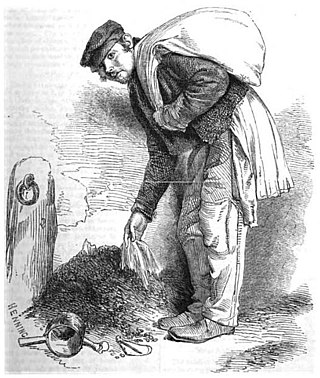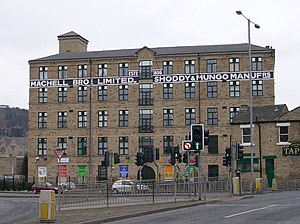
West Yorkshire is a metropolitan and ceremonial county in the Yorkshire and the Humber region of England. It borders North Yorkshire to the north and east, South Yorkshire and Derbyshire to the south, Greater Manchester to the south-west, and Lancashire to the west. The city of Leeds is the largest settlement.

Batley is a market town in the Metropolitan Borough of Kirklees, West Yorkshire, England, south-west of Leeds, north-west of Wakefield and Dewsbury, south-east of Bradford and north-east of Huddersfield, in the Heavy Woollen District. In 2011, the population was 48,730.

Dewsbury is a market town in the Metropolitan Borough of Kirklees in West Yorkshire, England. It lies on the River Calder and on an arm of the Calder and Hebble Navigation waterway. It is to the west of Wakefield, east of Huddersfield and south of Leeds. Historically a part of the West Riding of Yorkshire, after undergoing a period of major growth in the 19th century as a mill town, Dewsbury went through a period of decline. Dewsbury forms part of the Heavy Woollen District of which it is the largest town. The population of the built-up area was 63,722 at the 2021 Census.

Ossett is a market town in West Yorkshire, England. It is almost entirely within the local-authority area of the City of Wakefield, but a small area lies in Kirklees Metropolitan Borough. Historically part of the West Riding of Yorkshire, it is situated between Dewsbury, Horbury and Wakefield. At the 2021 census, the town had a population of 21,861. Ossett forms part of the Heavy Woollen District.

Cleckheaton is a town in the Metropolitan Borough of Kirklees, West Yorkshire, England. Historically part of the West Riding of Yorkshire, it is situated south of Bradford, east of Brighouse, west of Batley and south-west of Leeds. It is at the centre of the Spen Valley and was the major town in the former borough of Spenborough. Cleckheaton has a history as a mill town and forms part of the Heavy Woollen District.

Kirklees is a metropolitan borough of West Yorkshire, England. The borough comprises the ten towns of Batley, Birstall, Cleckheaton, Dewsbury, Heckmondwike, Holmfirth, Huddersfield, Meltham, Mirfield and Slaithwaite. It is governed by Kirklees Council. Kirklees had a population of 422,500 in 2011; it is the third-largest metropolitan district in England by area size, behind Doncaster and Leeds.

Heckmondwike is a town in the Metropolitan Borough of Kirklees, West Yorkshire, England, 9 miles (14 km) south west of Leeds. Historically part of the West Riding of Yorkshire, it is close to Cleckheaton and Liversedge. It is mostly in the Batley and Spen parliamentary constituency, and had an estimated population of 16,986 at the 2011 Census increasing to 18,149 at the 2021 Census. Heckmondwike forms part of the Heavy Woollen District.

Batley and Spen is a constituency in the House of Commons of the UK Parliament. The current MP is Kim Leadbeater, a Labour politician, elected in a 2021 by-election by a 323-vote margin. The seat has returned Labour MPs since the 1997 general election.

Liversedge is a town and former parish of Birstall, in the Metropolitan Borough of Kirklees, West Yorkshire, England. Historically part of the West Riding of Yorkshire, Liversedge lies between Cleckheaton and Heckmondwike. The Kirklees ward is now called Liversedge and Gomersal with a population at the 2011 Census of 19,420. Liversedge forms part of the Heavy Woollen District.

A rag-and-bone man or ragpicker or ragman, old-clothesman, junkman, or junk dealer, also called a bone-grubber, bone-picker, chiffonnier, rag-gatherer, bag board, or totter, collects unwanted household items and sells them to merchants. Scraps of cloth and paper could be turned into cardboard, while broken glass could be melted down and reused, and even dead cats and dogs could be skinned to make clothes. Traditionally, this was a task performed on foot, with the scavenged materials kept in a small bag slung over the shoulder. Some rag-and-bone men used a cart, sometimes pulled by a horse or pony.

The A638 is a major road in England. It runs between the A1 at Markham Moor, Nottinghamshire and Chain Bar Interchange – Junction 26 of the M62 motorway, south of Bradford in West Yorkshire.
Spen Valley was a parliamentary constituency in the valley of the River Spen in the West Riding of Yorkshire. It returned one Member of Parliament (MP) to the House of Commons of the Parliament of the United Kingdom.
The WF postcode area, also known as the Wakefield postcode area, is a group of 17 postcode districts in north-east England, which are subdivisions of eleven post towns. These cover much of southern and eastern West Yorkshire, plus small parts of South and North Yorkshire.

Staincliffe is a cross-over district of both Batley and Dewsbury, in West Yorkshire, England. Historically part of the West Riding of Yorkshire, the name is believed to derive from staine, meaning stone and cliffe, cliff.

HWD Hospital Radio is a hospital radio station which broadcasts to the patients and staff of Mid Yorkshire Trust hospitals in West Yorkshire, England. The station is a member of the Hospital Broadcasting Association and is registered as a charity with the Charity Commission for England and Wales, number 227515.

Frederic Wilfrid "Wilf" Hoyle Auty, also known by the nickname of "The Emperor", was an English rugby union, and amateur rugby league footballer who played as a winger or centre in the 1890s and 1900s, and rugby union coach of the 1900s, and 1910s.

The Spen Valley Line was a railway that connected Mirfield with Low Moor through the Spen Valley in West Yorkshire, England. Opened up by the Lancashire and Yorkshire Railway in 1847, with full opening to Low Moor in 1848, the line served a busy industrial and textile area and allowed a connection for trains between Huddersfield and Bradford. The line was absorbed by the London & North Western Railway, the London Midland and Scottish Railway (LMS) and British Railways on Nationalisation. A separate link between Heckmondwike Central and Thornhill that opened later and was known as the Ravensthorpe Branch, allowed through running to Wakefield and beyond. The line was closed down to passengers in 1965 with freight continuing sporadically until 1981. A Spur onto the former Leeds New Line from the Ravensthorpe Branch kept the very southern end open until the late 1980s. The majority of the route is now the Spen Valley Greenway cycle path.

Recycled wool, also known as rag wool or shoddy is any woollen textile or yarn made by shredding existing fabric and re-spinning the resulting fibres. Textile recycling is an important mechanism for reducing the need for raw wool in manufacturing.

















